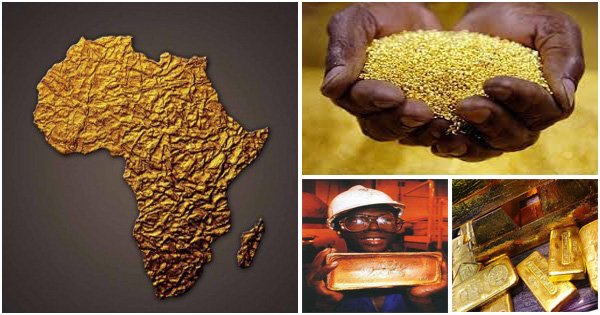Africa is the third largest gold producing continent in the world, and has gold mining activities in more than 21 of its countries. Ghana, one of the world's leading countries in gold production, and the number one producer in Africa, produced approximately 150 metric tons of gold in 2020.
Africa’s gold mining industry — traditionally dominated by South Africa — has seen a shift in focus with countries such as Ghana, Suda, Mali, and Burkina Faso entering the fray.
Major companies such as Newmont Goldcorp, Kinross Gold, AngloGold Ashanti, Barrick Gold and Gold Fields are active in the region, alongside controversial artisanal miners, who are especially active in Ghana, Mali and Burkina Faso.
Top five gold mining countries of Africa from Ghana to Burkina Faso
MININGOTHER COMMODITIESRARE EARTH METALS
By NS Energy Staff Writer 28 Aug 2020
Africa's gold mining industry — traditionally dominated by South Africa — has shifted focus with countries such as Ghana, Mali and Burkina Faso entering the fray
bullion-by Erik Stein from Pixabay
Gold bullion. Credit: Erik Stein/Pixabay
Africa’s gold mining industry — traditionally dominated by South Africa — has seen a shift in focus with countries such as Ghana, Suda, Mali, and Burkina Faso entering the fray.
Major companies such as Newmont Goldcorp, Kinross Gold, AngloGold Ashanti, Barrick Gold and Gold Fields are active in the region, alongside controversial artisanal miners, who are especially active in Ghana, Mali and Burkina Faso.
Top five gold mining countries of Africa
From Ghana to Burkina Faso we profile the leading gold producers across the African continent.
- Ghana – 142.4 tonnes
One of the Dark Continent’s top gold mining countries, Ghana grabbed the top spot from South Africa after mining more than 142 metric tonnes of the precious metal in 2019.
While traditional companies and artisanal miners contributing to Ghana’s gold production, some of the largest include Kinross Gold (Chirano mine), Newmont Goldcorp (Akyem and Ahafo mines), AngloGold Ashanti (Obuasi and Iduapriem mines), Gold Fields (works the Tarkwa gold mine) and Asanko Gold (Asanko mine).
The minerals mined in Ghana account for 37% of the country’s total exports, with gold comprising 90% of total mineral exports. Miningglobal.com estimates Ghana’s gold reserves to be 1,000 metric tonnes.
- South Africa – 118.2 tonnes
Declining gold ore grades in South Africa over the past eight decades have seen the country lose its African top spot to Ghana. In 2019, gold production fell to 118 metric tonnes from 137 metric tonnes in the previous year.
Table Mountain, Cape Town, South Africa (Credit: Counselling/Pixabay)
The Witwatersrand Basin, an underground geological formation in South Africa, holds one of the largest gold placer deposits in the world. Top gold mines in the country include South Deep (the largest gold mine in the world in terms of reserves and currently owned by Harmony Gold), Mponeng (operated by AngloGold Ashanti and the deepest mine in the world) and Driefontein (owned by Sibanye-Stillwater). South Africa’s oldest mine, Kromdraai, is a currently a huge tourist attraction.
Despite diminishing gold reserves, South Africa is still estimated to possess 6,000 metric tonnes (second-largest in the world), according to 2018 MiningGlobal data.
- Sudan – 76.6 tonnes
The north-east African country of Sudan comes third in this list with gold production of more than 76 metric tonnes in 2019. This was, however, a big drop from the 93 tonnes produced the previous year and the 107 tonnes in 2017. The Sudanese government, however, claims annual gold production in the range of 120-200 tonnes.
Hassai open pit mine, in the Red Sea Hills desert of north-eastern Sudan, began operations in 1992 (Credit: La Mancha Resources)
For years one of Africa’s top gold producing countries, Sudanese gold is found in the Eriab region of the Nuba mountains, along the alluvial regions of the Nile River and quartz vein formations in Obaidiya, Blue Nile region and North Kurdufan.
Africa’s third-largest country by area, Sudan’s gold mines include Hassai gold mine (owned by Sudan’s Ariab Mining Company and Canada’s La Mancha Resources) and Block 14 open pit mine project (operated by Canada’s Orca Gold).
- Mali – 71.1 tonnes
The north-west African country of Mali produced more than 71 metric tonnes of gold in 2019, a sizeable jump from the 61.2 tonnes in 2018 — placing it fourth in our list of the continent’s top gold producers. Mali’s gold mining operations not only involve large mining companies, but also artisanal miners, who have also produced a sizeable chunk of gold and made a significant contribution to the country’s economy.
Gold mine tunnel

Its gold mines include Morila (managed by Government of Mali, AngloGold Ashanti and Barrick Gold), Sadiola (managed by Government of Mali, AngloGold Ashanti and LamGold), Loulo-Gounkoto (managed by Barrick Gold) and Yatela (managed by Government of Mali, AngloGold Ashanti and LamGold).
Mali is estimated to have 800 metric tonnes of gold reserves, according to Norwegian website Eiti.org.
- Burkina Faso – 62 tonnes
Burkina Faso’s 62 metric tonnes of gold produced in 2019 places it in fifth position in our list. Said to have one of the most dynamic mining sectors in West Africa, Burkina Faso‘s other major resources are copper, zinc, limestone, manganese and phosphate.
The country’s gold mines include Kalsaka (operated by Banlaw Africa Limited), Youga (jointly operated by Government of Burkina Faso and Etruscan Resource), Karma (operated by Endeavour Mining), Mana (operated by Semafo), Yaramoko (operated by Roxgold), Taparko-Boroum (owned and operated by Société des Mines de Taparko SA), Essakane (operated by IAMGOLD), and Inata (jointly operated by the Government of Burkina Faso and Avocet).
Burkina Faso’s gold reserves are estimated to be about 154 metric tonnes
Your post has been upvoted by @mostofajaman Community Curation Trail.
SUBSCRIBE NOW STEEM FARMING COMMUNITY
Downvoting a post can decrease pending rewards and make it less visible. Common reasons:
Submit